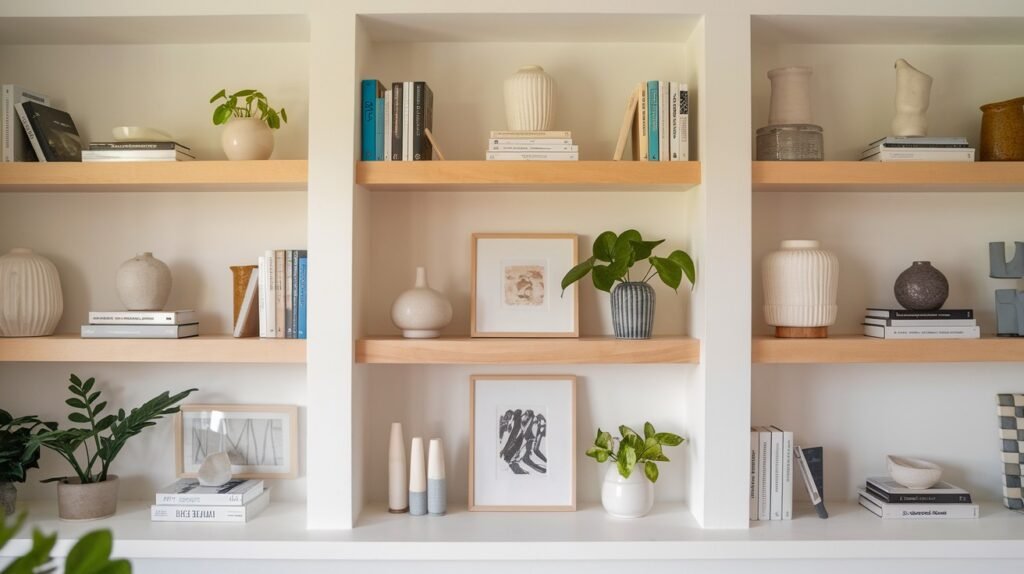Open shelves offer incredible potential to showcase your personality while adding function to any room.
But staring at empty shelves can feel overwhelming. How do you create displays that look intentionally styled rather than cluttered or bare?
The key lies in understanding that great shelf decorating ideas go beyond simply placing objects randomly.
It’s about creating visual balance, telling your story through meaningful pieces, and making your space feel authentically yours.
From mixing textures and playing with asymmetry to incorporating plants and rotating seasonal touches, the right approach can turn basic shelving into stunning focal points.
Ready to turn those blank shelves into conversation starters? These proven strategies will help you create displays that perfectly blend style with functionality, making your home more beautiful and organized.
How to Choose the Right Shelf for Your Space?
Before diving into styling, selecting the perfect shelf sets the foundation for success.
Start by assessing your room size; large spaces can handle chunky, statement shelving, while smaller rooms benefit from sleek floating options that won’t overwhelm.
Consider your wall type, too. Drywall supports lighter floating shelves, but brick or concrete walls can handle heavier ladder-style or robust wall-mounted units.
Popular options include floating shelves for minimalist appeal, corner shelves for awkward spaces, ladder shelves for rustic charm, and traditional wall-mounted brackets for maximum support.
Material choice matters significantly. Wood brings warmth and works with farmhouse or traditional styles, while metal suits industrial or modern spaces.
Glass shelves feel light and contemporary, perfect for small bathrooms or kitchens. Match your shelf’s finish to existing hardware and furniture for a cohesive, intentional look.
11 Unique Shelf Decorating Ideas You’ll Love
1. Play with Asymmetry
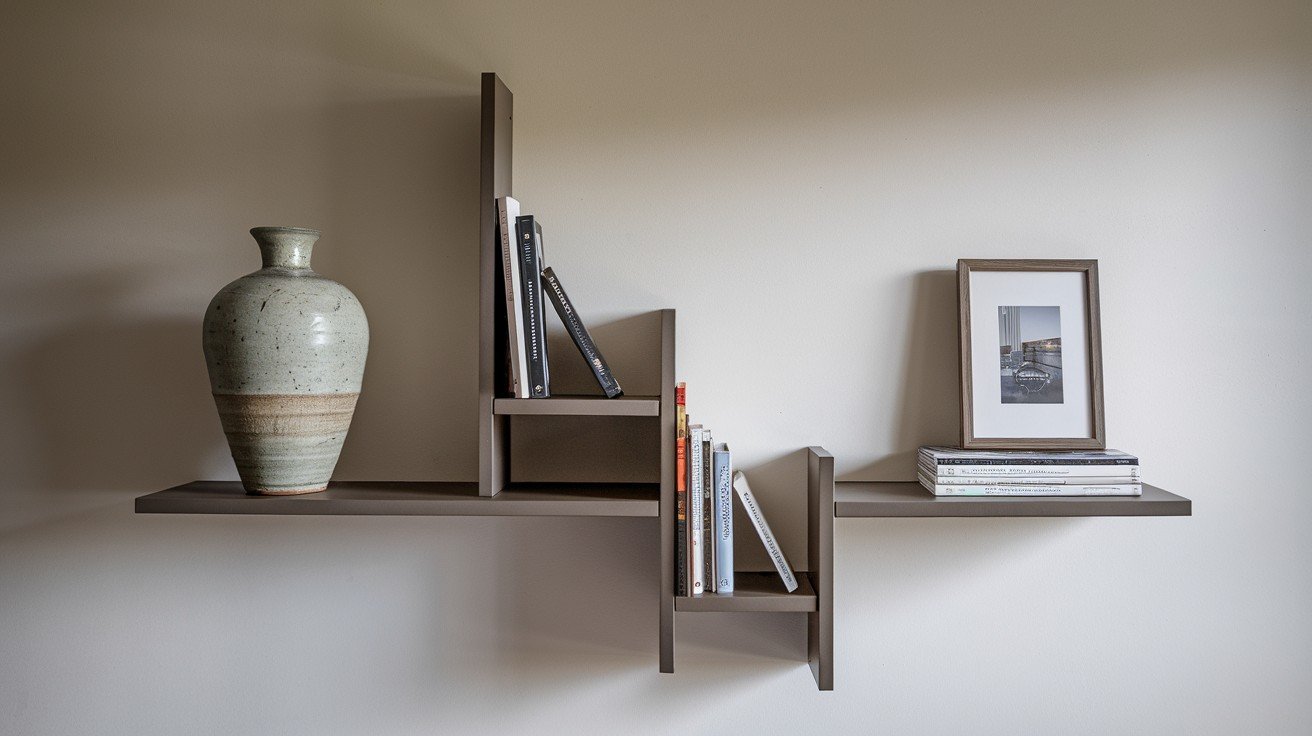
Forget perfect symmetry; intentionally uneven arrangements create visual interest and feel more natural. Place a tall vase on one side, balance it with smaller grouped items on the other.
Vary heights and spacing between objects. This approach mimics how professional designers style spaces, making your shelves look curated rather than rigid.
The key is creating balance through visual weight, not mirror-image placement.
2. Mix Textures and Materials
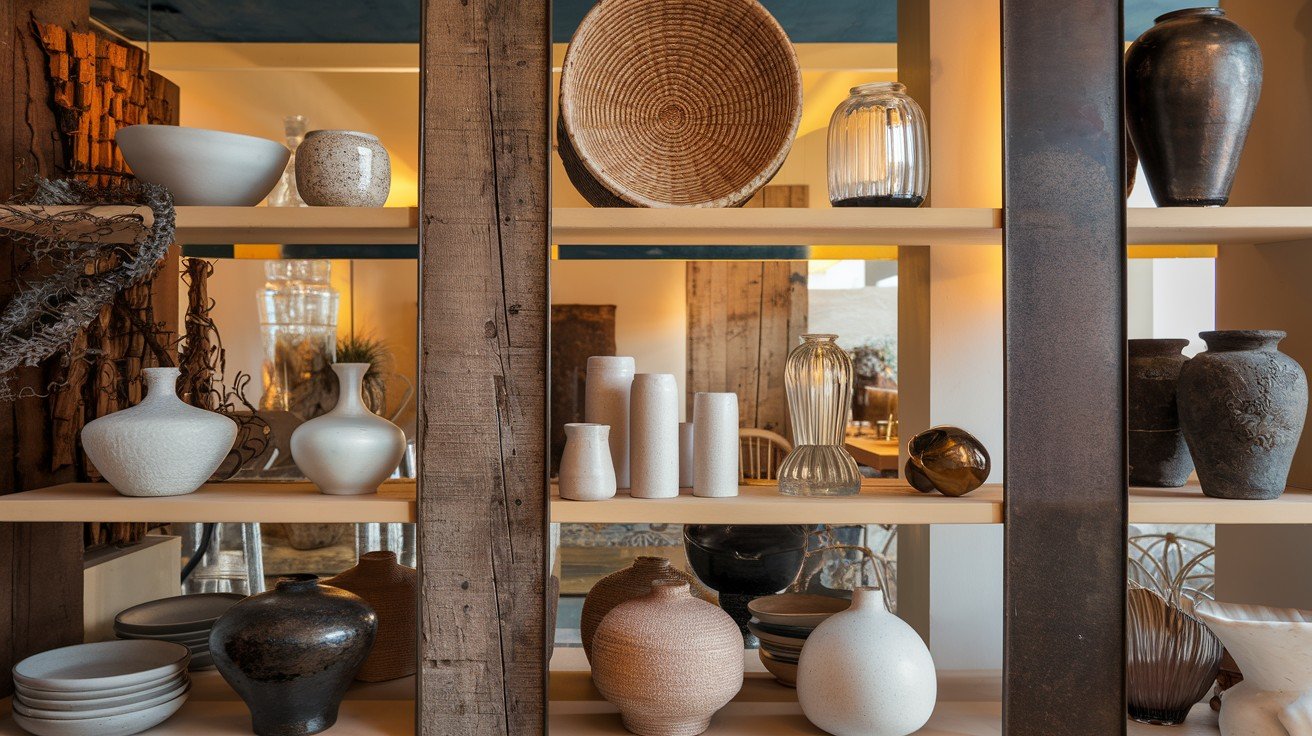
Combine different materials to add depth and prevent monotony. Pair smooth ceramics with rough woven baskets, glossy glass with matte wood, or cold metal with soft fabric elements.
This contrast creates tactile interest even from a distance. Try placing a wooden bowl next to a brass candlestick and a ceramic plant pot; the varied surfaces catch light differently and keep the eye engaged.
3. Add a Touch of Greenery
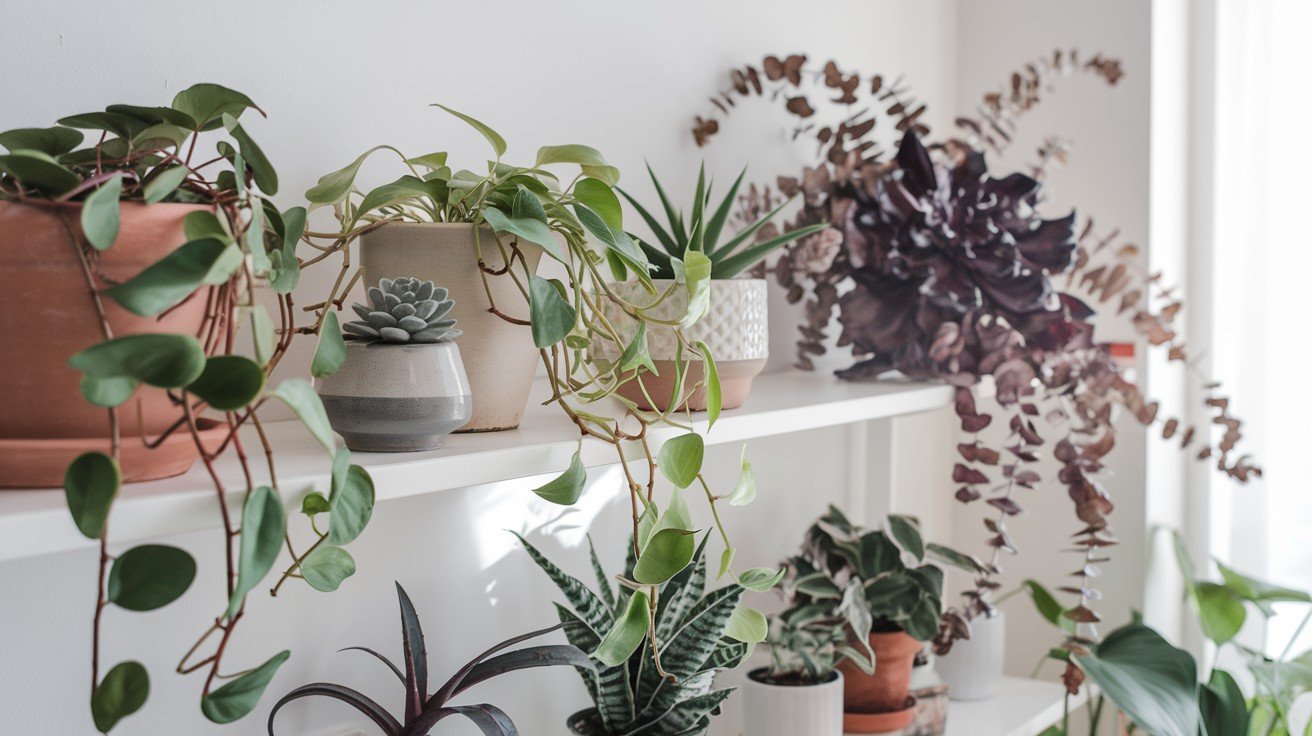
Plants instantly breathe life into shelf displays. Trailing pothos or ivy creates movement, while compact succulents add sculptural interest without overwhelming small spaces.
Dried eucalyptus or pampas grass works well if you prefer low-maintenance options. Position plants at different heights and let some cascade over shelf edges.
Even artificial plants can work if they look realistic; the goal is to add organic shapes and natural color.
4. Showcase Personal Collections
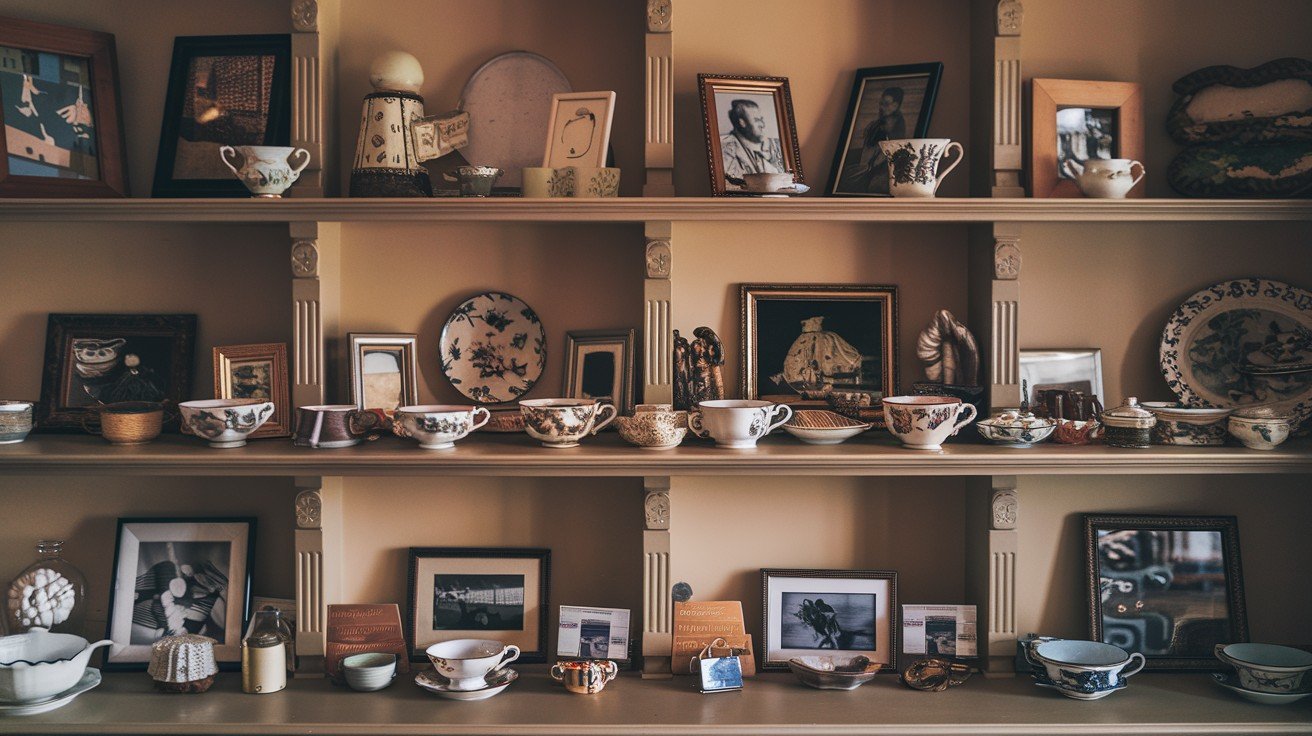
Group meaningful items that tell your story, vintage teacups, travel souvenirs, or handmade pottery. Display collections in odd numbers and vary heights for visual appeal.
Leave breathing room between pieces so each item can be appreciated individually. This personal touch makes your space unique and creates conversation starters.
Rotate pieces occasionally to keep displays fresh while highlighting different aspects of your collection.
5. Layer Art and Frames
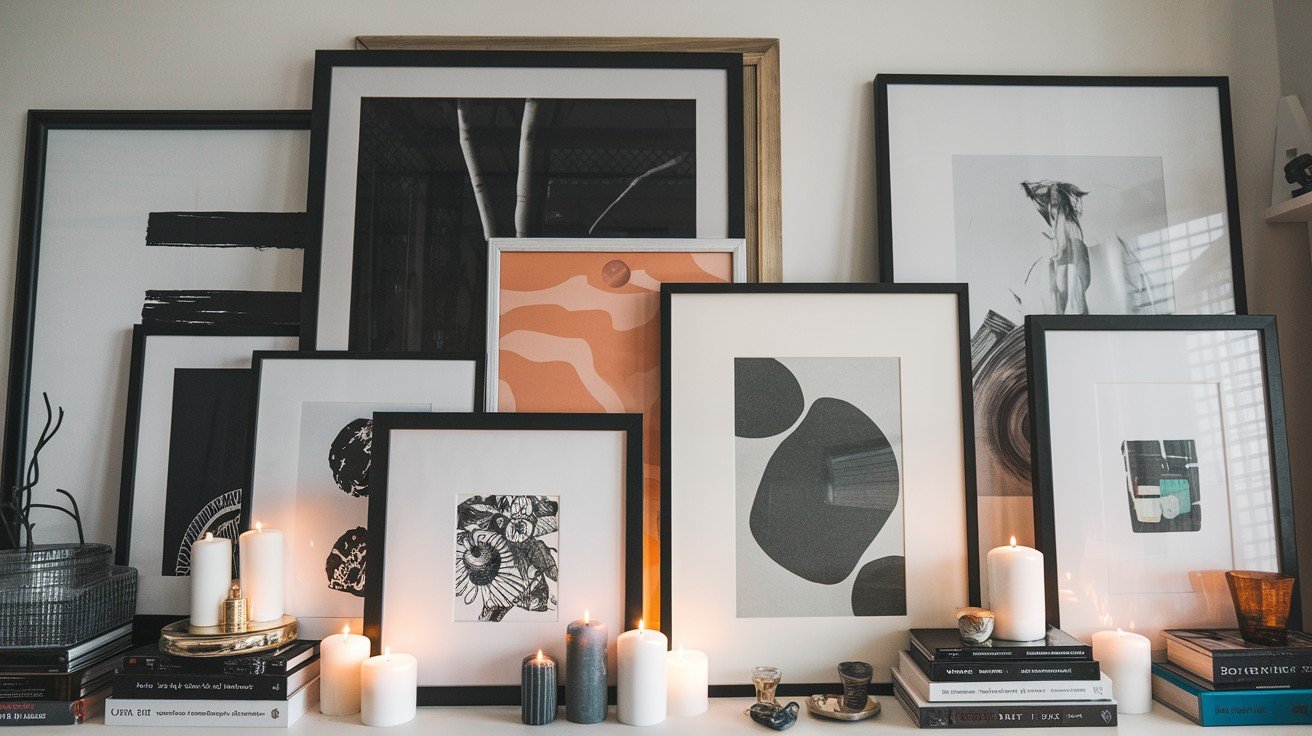
Create depth by leaning framed artwork against the wall behind other objects. Mix frame sizes and overlap them slightly for a gallery-like feel.
Combine photographs, prints, and small paintings at different heights. This layering technique adds dimension and prevents flat, one-dimensional displays.
Leave some frames partially hidden behind objects; this creates intrigue and makes the arrangement feel more organic and lived-in.
6. Use Odd Numbers in Groupings
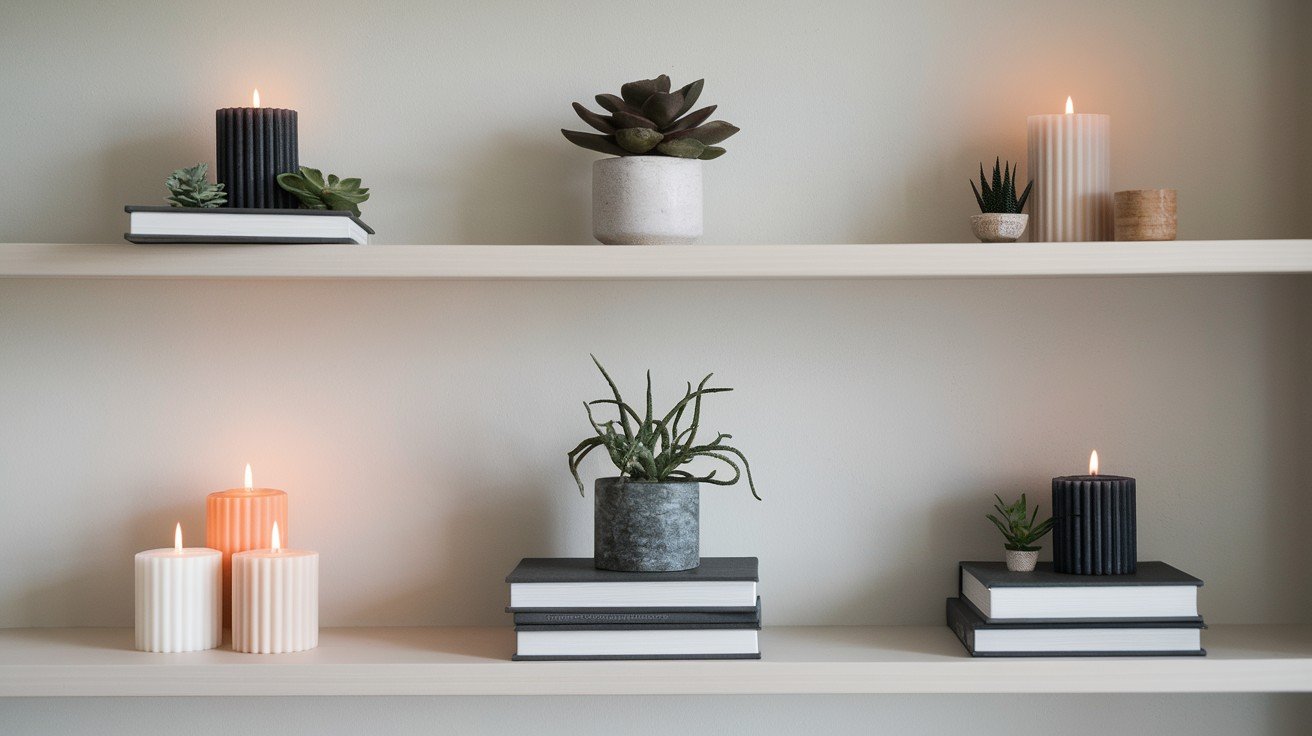
The “rule of three” creates more visually pleasing arrangements than even numbers. Group items in sets of three, five, or seven for natural-looking displays.
This principle works because odd numbers feel more dynamic and less static than even groupings. Apply this to books, candles, small plants, or decorative objects.
Vary the heights within each grouping to maintain visual interest and prevent the arrangement from looking too uniform.
7. Incorporate Lighting
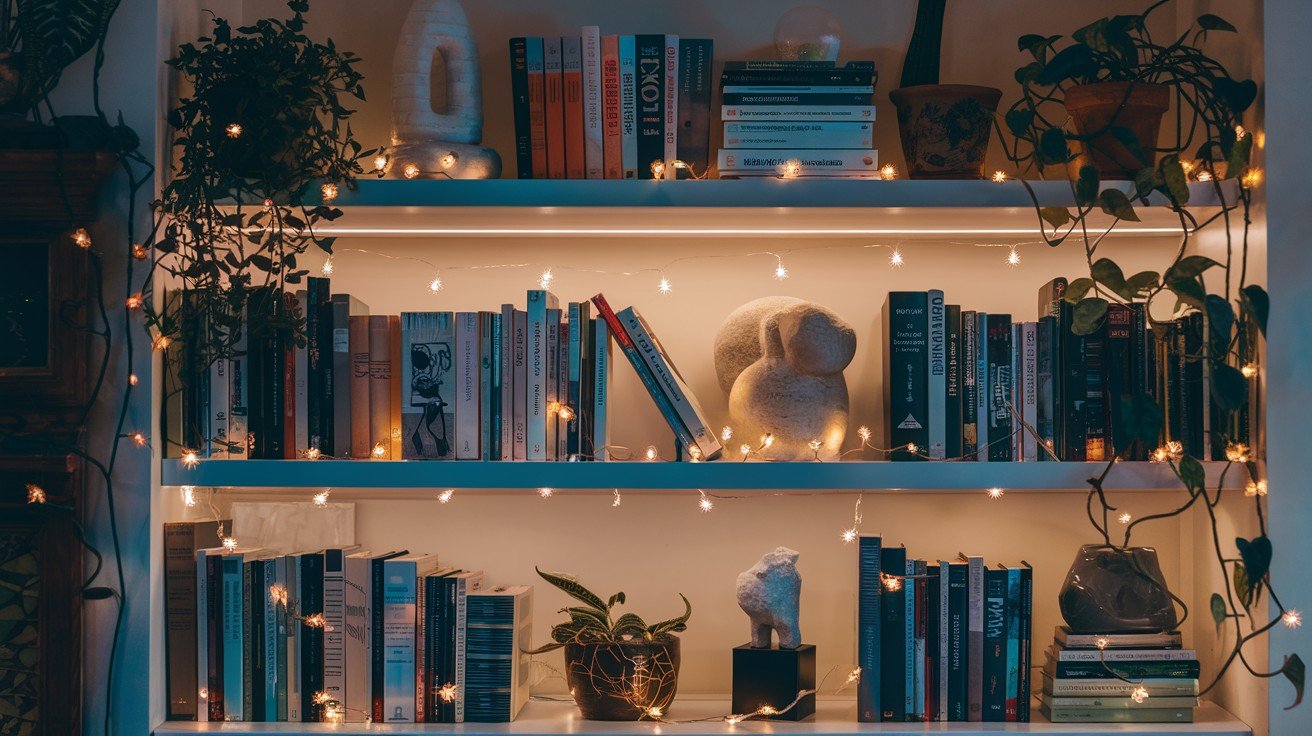
Strategic lighting turns ordinary shelves into focal points. Battery-operated LED strips hidden under shelves create an ambient glow without visible wires.
Fairy lights add whimsy, while small table lamps provide functional task lighting. Consider uplighting to highlight textured wall surfaces or backlighting to create silhouettes of interesting objects.
Good lighting makes colors pop, creates mood, and extends the usability of your shelved space into evening hours.
8. Stack Books Creatively
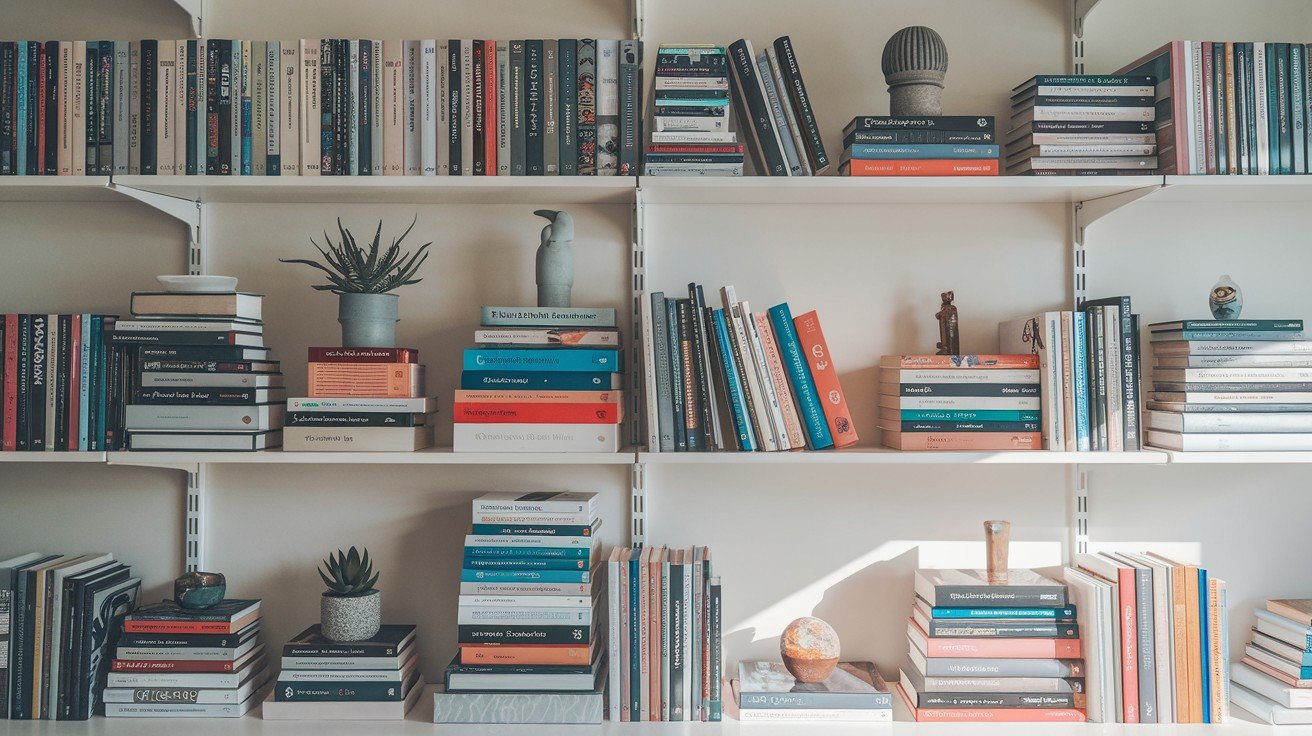
Break up monotonous vertical book spines by mixing in horizontal stacks. Use horizontal books as platforms for small decorative objects or plants.
This creates varied heights and adds visual rhythm to your display.
Mix book colors and sizes intentionally; alternate light and dark spines, or group books by color for a rainbow effect. Leave some space between book groups to prevent overcrowding and allow other decorative elements to shine.
9. Play with Color Palettes
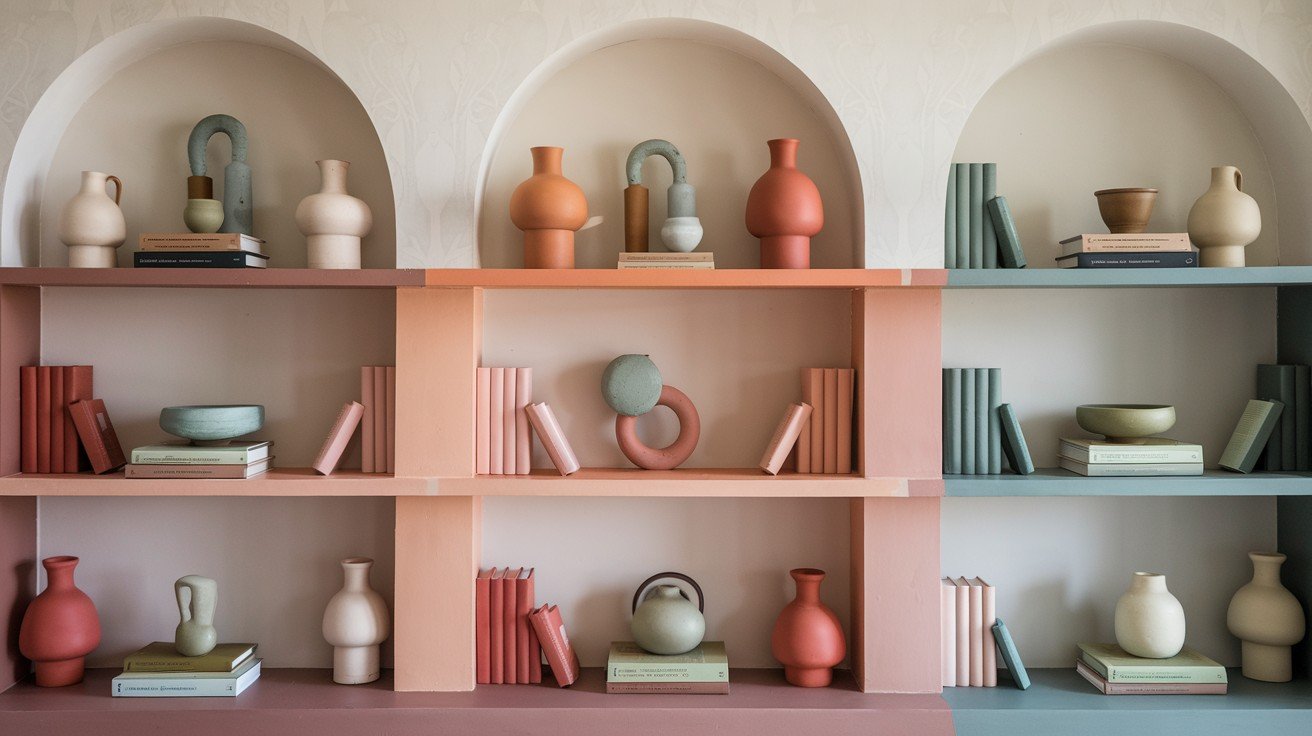
Coordinate shelf decor with your room’s color scheme for cohesion, or introduce bold accent colors for visual pop. Stick to 2-3 main colors plus neutrals to avoid chaos.
Group similar colors together, then break them up with neutral elements. Consider the psychology of colors, blues feel calming, while oranges energize.
Seasonal color swaps keep displays fresh without major rearrangement of furniture or permanent decor elements.
10. Add Sculptural or Whimsical Objects
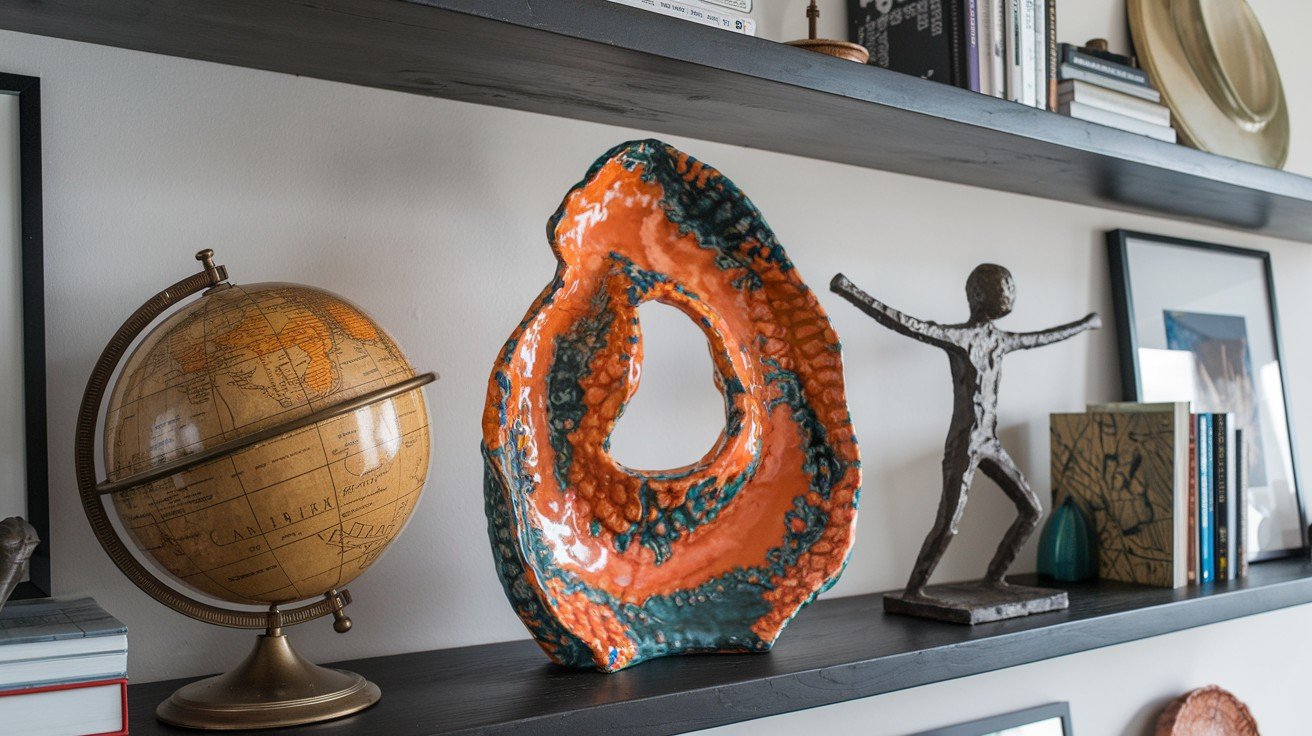
Include pieces that serve as conversation starters: interesting sculptures, unique vintage finds, or handmade ceramics with unusual shapes.
These statement pieces anchor your display and reflect your personality. Balance bold objects with simpler items to prevent visual overload.
Think beyond traditional decor; interesting rocks, driftwood, or architectural salvage can add character. The goal is to create focal points that make people stop and look closer.
11. Switch It Up Seasonally
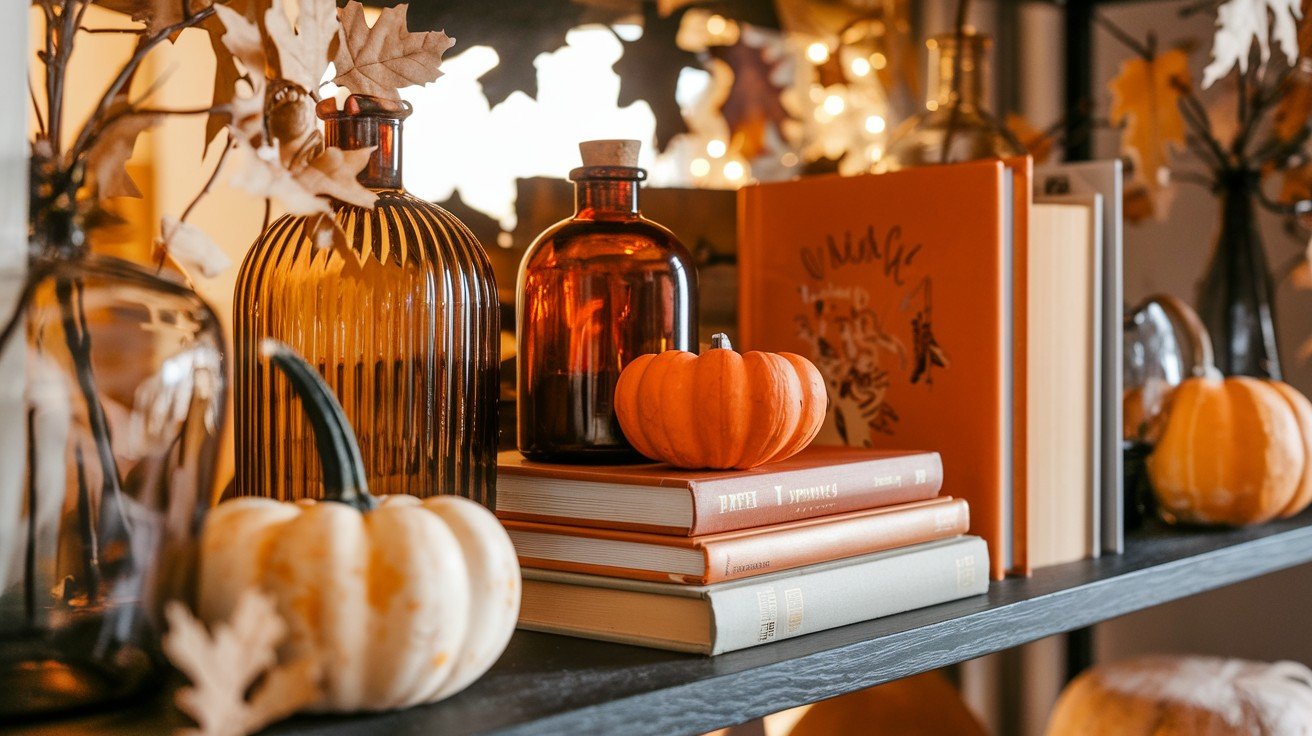
Treat your shelves as a rotating gallery space by swapping decorative elements with the seasons. Spring calls for fresh flowers and light colors, summer brings bright accents and beach finds, fall introduces warm tones and natural elements, and winter features cozy textures and metallic accents.
This keeps your space feeling current and prevents decorating fatigue. Store off-season items in bins, making seasonal switches quick and manageable without major overhauls.
Storage vs. Display: Finding the Balance
|
Aspect |
Prioritize Aesthetics |
Prioritize Function |
Balanced Approach |
|
Best For |
Living rooms, guest areas, and formal spaces |
Home offices, kitchens, kids’ rooms |
Family rooms, bedrooms, multi-use spaces |
|
Item Ratio |
80% decorative, 20% functional |
80% functional, 20% decorative |
50/50 split with dual-purpose items |
|
Storage Solutions |
Beautiful boxes, vintage containers, statement baskets |
Clear bins, labeled containers, and efficient organizers |
Stylish baskets with hidden contents, decorative boxes with a practical use |
|
Visual Appeal |
Curated, magazine-worthy look |
Clean, organized, accessible |
Attractive yet practical, lived-in feel |
|
Maintenance |
Higher – frequent dusting, careful arrangement |
Lower – easy to grab and replace items |
Moderate – occasional styling refresh |
Hidden Storage Ideas for Open Shelves
|
Storage Type |
What It Hides |
Style Benefit |
Best Placement |
|
Woven Baskets |
Toys, linens, and office supplies |
Adds texture and warmth |
Lower shelves for easy access |
|
Decorative Boxes |
Important papers, cables, and small items |
Creates clean lines, hides clutter |
Upper shelves or back corners |
|
Vintage Suitcases |
Seasonal items, memories, and extra bedding |
Adds character and story |
Statement pieces on prominent shelves |
|
Fabric Bins |
Children’s items, craft supplies |
Soft texture, comes in many colors |
Kid-height shelves, craft areas |
|
Glass Jars |
Pantry items, bathroom essentials |
Shows contents while containing them |
Kitchen and bathroom shelves |
Blending Baskets, Boxes, and Decorative Bins
|
Combination Strategy |
Visual Effect |
Practical Benefit |
Example Setup |
|
Mix Materials |
Varied textures prevent monotony |
Different materials suit different items |
Wicker basket + metal box + fabric bin |
|
Vary Heights |
Creates visual rhythm |
Accommodates different item sizes |
Tall narrow box + low wide basket + medium bin |
|
Color Coordination |
Cohesive, intentional look |
Easy to match room decor |
All neutral tones or matching accent colors |
|
Strategic Placement |
Guide eye movement |
Most-used items at convenient heights |
Daily items in baskets, seasonal in high boxes |
|
Label Integration |
Maintains organization |
Family members know where things belong |
Subtle tags on baskets, printed labels on boxes |
Conclusion
Creating beautiful, functional shelf displays doesn’t require professional design skills – just thoughtful planning and personal touches.
The best arrangements balance visual appeal with practical needs, reflecting your unique style while serving your daily life.
Remember that great shelf styling is an ongoing process, not a one-time project.
Start with one or two techniques that resonate with you, then gradually build complexity as you gain confidence.
Don’t be afraid to rearrange items, swap seasonal elements, or try new combinations.
Your shelves should make you smile every time you see them. By mixing textures, playing with asymmetry, incorporating meaningful objects, and maintaining that crucial storage-display balance, you’ll create spaces that are both beautiful and livable.
The most successful shelf displays tell your story while enhancing your home’s functionality – and that’s exactly what makes a house feel like home.
Frequently asked questions
How often should I change my shelf displays?
Refresh seasonally or when you feel bored. Small tweaks monthly keep things interesting without major rearrangement.
What’s the biggest mistake people make when decorating shelves?
Overcrowding spaces. Leave breathing room between items so each piece can be appreciated, and cleaning remains manageable.
How do I style shelves without looking cluttered?
Follow the rule of three, vary heights, and mix functional storage with decorative pieces for balanced visual appeal.

